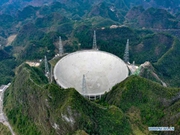

More proactive fiscal policy was pursued, and the increase in the fiscal deficit was used mainly to cover tax and fee cuts. The trial replacement of business tax with value added tax (VAT) was extended to cover all sectors, slashing the tax burden of businesses for the year by over 570 billion yuan and reducing tax burdens in every sector. A transitional plan for sharing VAT revenue between the central and local governments was formulated and implemented to ensure financial resources of local governments remained unchanged. More local government bonds were issued to replace outstanding debts, reducing interest payments by roughly 400 billion yuan.
A prudent monetary policy was pursued in a flexible and appropriate manner.The M2 money supply increased by 11.3 percent, below our projected target of around 13 percent. We used a range of monetary policy tools to support the development of the real economy.
Measures were taken to upgrade consumption. We unveiled policies to encourage private investment, and saw investment begin to stabilize. We exercised category-based regulation over the real estate market. We strengthened efforts to manage financial risks. The RMB exchange rate regime continued to improve, and the exchange rate remained generally stable at an adaptive and equilibrium level. With these measures, we have safeguarded China's economic and financial security.
Second, we focused on five priority tasks -- cutting overcapacity, reducing excess inventory, deleveraging, lowering costs, and strengthening areas of weakness -- thereby improving the composition of supply.
Particular priority was given to cutting overcapacity in the steel and coal sectors. Over the year, steel production capacity was cut by more than 65 million metric tons and coal by over 290 million metric tons, going beyond annual targets. Effective assistance was provided to laid-off employees.
We supported migrant workers in buying urban homes; and we increased the proportion of people affected by rebuilding in rundown urban areas receiving monetary compensation, making good progress in reducing real estate inventory.
Business acquisitions and reorganizations were encouraged, direct financing was promoted, and market- and law-based debt-to-equity swaps were carried out, lowering the debt-to-asset ratio of industrial enterprises.
To help enterprises lower operating costs, we introduced measures to cut taxes and fees, lower the share paid by enterprises for social security contributions,(1) and cut the price of electricity.
We boosted efforts to strengthen areas of weakness and undertook major initiatives that both help to meet urgent needs today and promise long-term benefits.
Third, we worked hard to deepen reform and opening up, further strengthening the vitality of development.
Reform was deepened across the board, and a good number of landmark and pillar reform initiatives were undertaken.
To balance the government-market relationship -- the pivotal issue in economic structural reform -- we continued reforms to streamline administration, delegate powers, and improve regulation and services. My administration's goal of cutting the number of items requiring government review by a third had been achieved ahead of schedule. On that basis, last year we cancelled the requirement on a further 165 items for review by State Council departments and authorized local governments. We also overhauled and standardized 192 items of intermediary services for government review as well as 220 items of approvals and accreditations for professional qualifications. We deepened institutional reforms in the business sector. We introduced an oversight model of random inspection and public release across the board,(2) made operational and post-operational oversight more effective, and promoted the Internet Plus government services model.
We pushed ahead with reforms to restructure and reorganize state-owned enterprises (SOEs) and introduce into them mixed ownership structures. We established a review system to ensure fair competition. We deepened resource tax reforms.
We improved measures for separating rural land ownership rights, contract rights, and management rights, and established a mechanism for determining whether people have been lifted out of poverty. We made progress in reforming the science and technology management system, gave greater autonomy to colleges and research institutes, and adopted profit distribution policies oriented toward increasing the value of knowledge. We opened up the elderly services market. We expanded the trials of comprehensive reforms in public hospitals and deepened reform of the evaluation and approval systems for medicine and medical equipment.
We formulated unified measures to determine and register natural resource rights. We piloted reforms for conducting direct oversight by provincial-level environmental protection agencies over the environmental monitoring and inspection work of environmental protection agencies below the provincial level, as well as crop rotation and fallow land reforms. The river chief system was introduced for all lakes and rivers across the country, and the mechanisms for compensating for ecological conservation efforts were improved. Reform has given new impetus to economic and social development.
We opened China wider to the rest of the world. As we pushed ahead with the Belt and Road Initiative, we worked to increase complementarity between the development strategies of, and practical cooperation between, China and other countries along the routes.
The RMB was formally included in the IMF's Special Drawing Rights basket. The Shenzhen-Hong Kong Stock Connect was launched. We improved measures for promoting trade, and built 12 new integrated experimental zones for cross-border e-commerce, bringing about a steady recovery in the volume of import and export.
The new practices of pilot free trade zones in Shanghai and elsewhere were used to establish another seven pilot zones. The requirement for review and approval for setting up and making significant adjustments to foreign enterprises was replaced by a simple filing process, with the exception of a few areas where special market access requirements apply. In 2016, China utilized more than US$130 billion of overseas investment, continuing to rank first among developing countries.
Fourth, we strengthened innovation's leading role, spurring the rapid development of new growth drivers.
We took further steps to implement the Internet Plus action plan and the national big data strategy, fully implemented the Made in China 2025 initiative, and implemented and improved policies and measures to encourage people to launch businesses and innovate. We developed and launched a plan for completing major science and technology programs by 2030, supported Beijing and Shanghai in building themselves into global R&D centers, and established another six national innovation demonstration zones.
Notes: (1) This includes old-age insurance, health insurance, unemployment insurance, workers' compensation, maternity insurance, and housing provident fund schemes.
(2) The model comprises inspections of randomly selected entities by randomly selected inspectors and the public release of inspection results.
 |  |

 Award-winning photos show poverty reduction achievements in NE China's Jilin province
Award-winning photos show poverty reduction achievements in NE China's Jilin province People dance to greet advent of New Year in Ameiqituo Town, Guizhou
People dance to greet advent of New Year in Ameiqituo Town, Guizhou Fire brigade in Shanghai holds group wedding
Fire brigade in Shanghai holds group wedding Tourists enjoy ice sculptures in Datan Town, north China
Tourists enjoy ice sculptures in Datan Town, north China Sunset scenery of Dayan Pagoda in Xi'an
Sunset scenery of Dayan Pagoda in Xi'an Tourists have fun at scenic spot in Nanlong Town, NW China
Tourists have fun at scenic spot in Nanlong Town, NW China Harbin attracts tourists by making best use of ice in winter
Harbin attracts tourists by making best use of ice in winter In pics: FIS Alpine Ski Women's World Cup Slalom
In pics: FIS Alpine Ski Women's World Cup Slalom Black-necked cranes rest at reservoir in Lhunzhub County, Lhasa
Black-necked cranes rest at reservoir in Lhunzhub County, Lhasa China's FAST telescope will be available to foreign scientists in April
China's FAST telescope will be available to foreign scientists in April